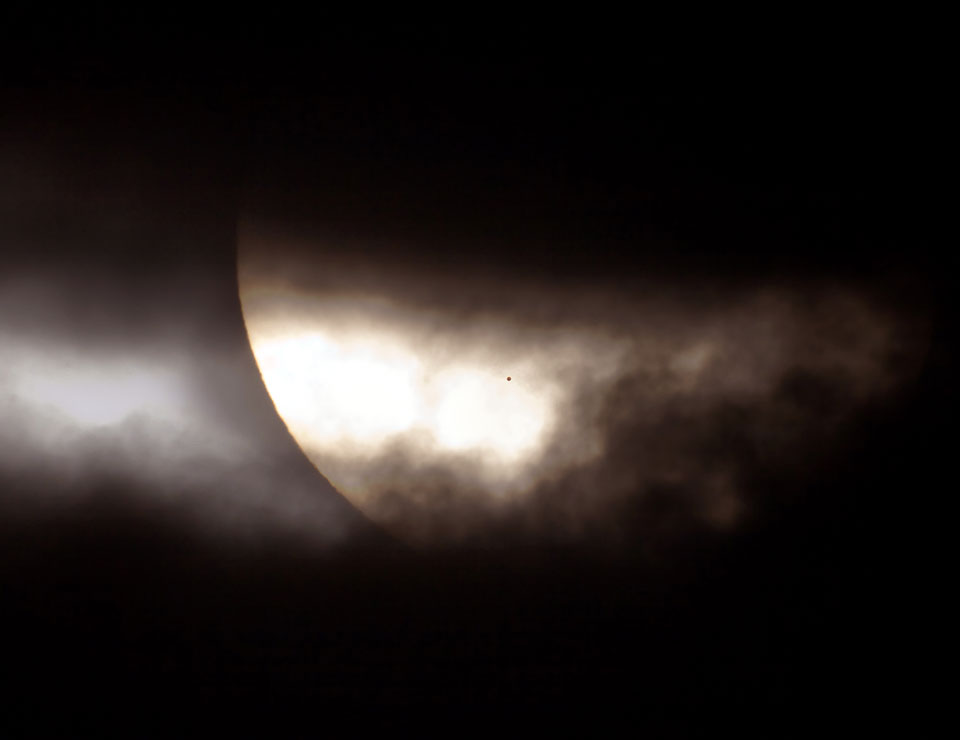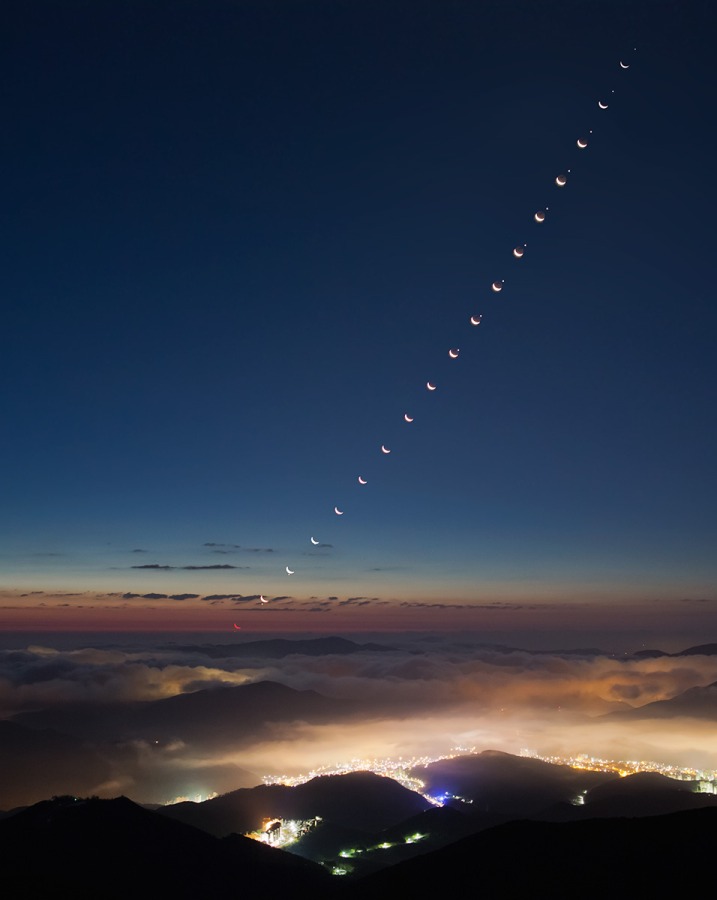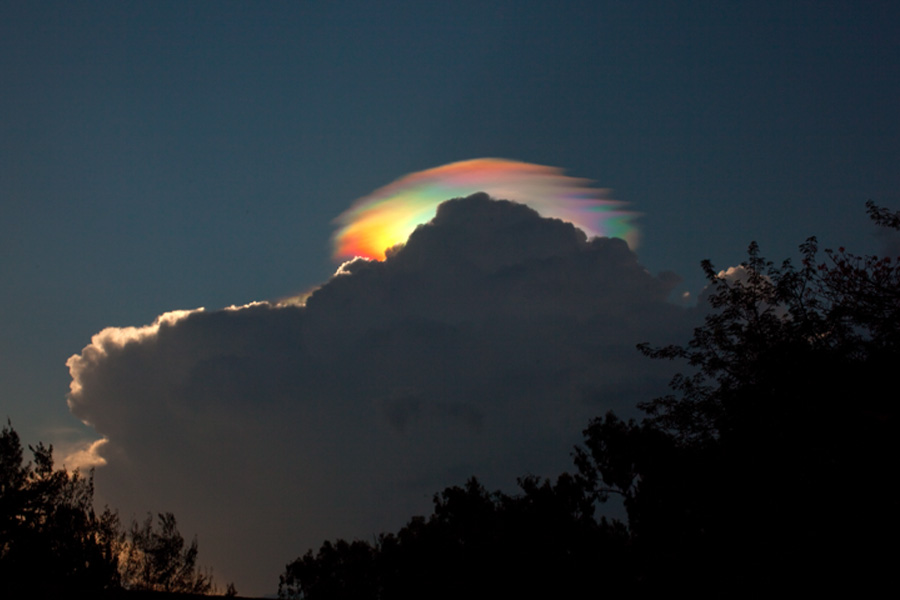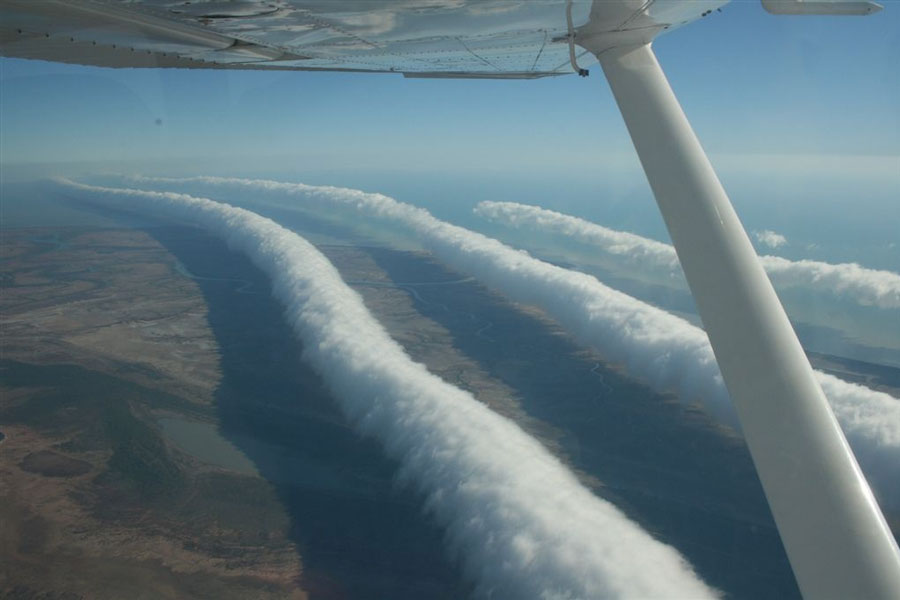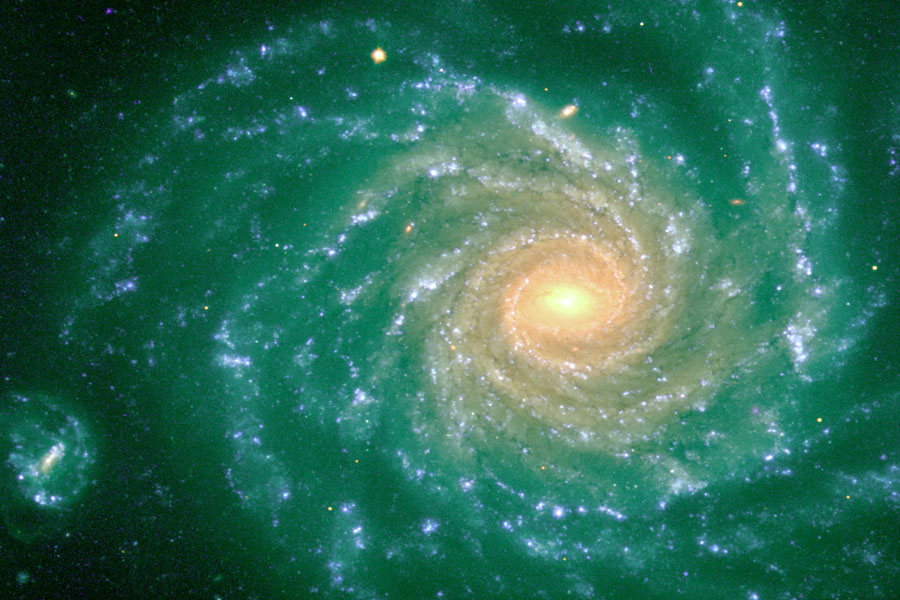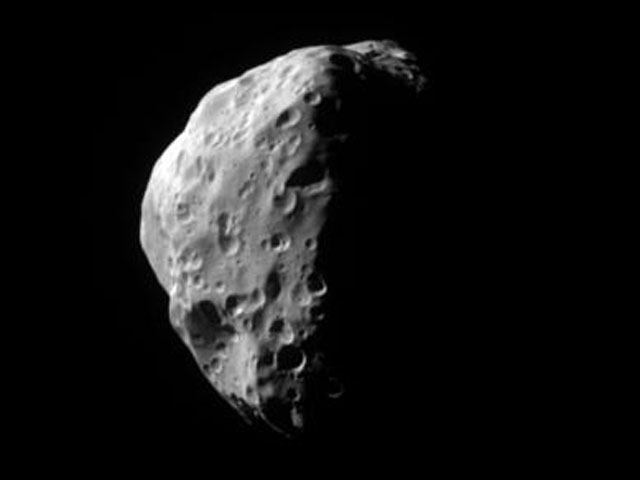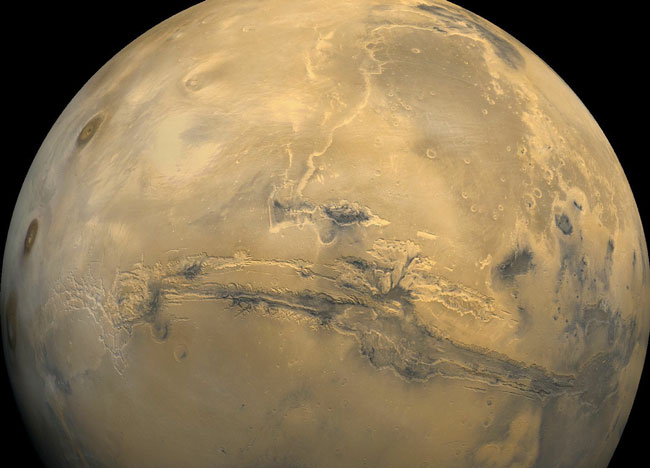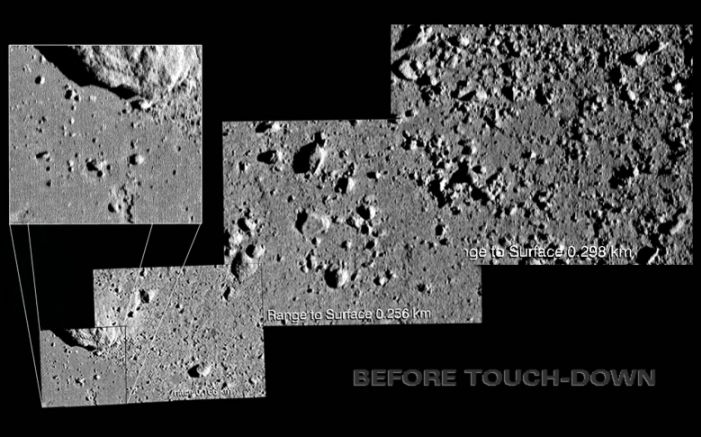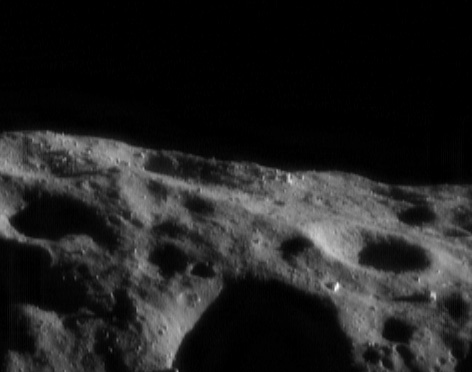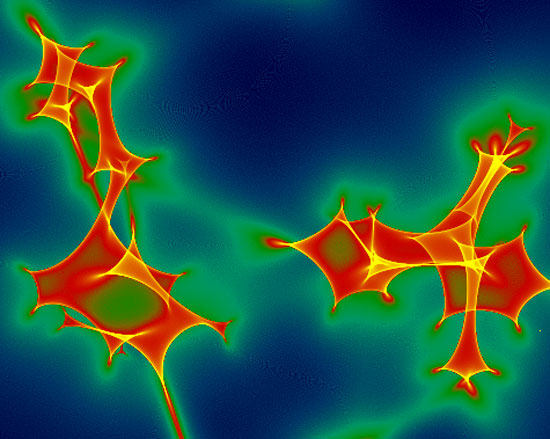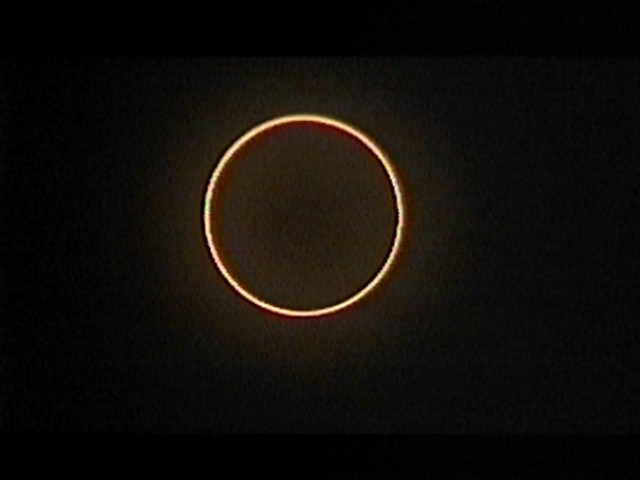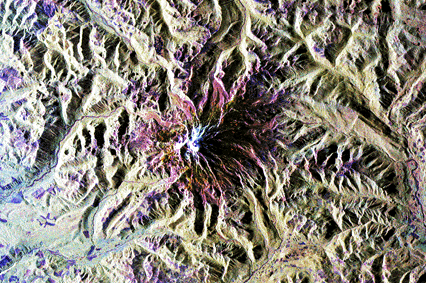| << Previous | Index | Next >> |
2015 What's happening in this strange juxtaposition of moon and planet? First and foremost, Saturn's moon Dione was captured here in a dramatic panorama by the robotic Cassini spacecraft currently orbiting the giant planet. The bright and cratered moon itself spans about 1100-km, with the large multi-ringed crater Evander visible on the lower right. Since the rings of Saturn are seen here nearly edge-on, they are directly visible only as a thin horizontal line that passes behind Dione. Arcing across the bottom of the image, however, are shadows of Saturn's rings, showing some of the rich texture that could not be seen directly. In the background, few cloud features are visible on Saturn. The featured image was taken during the last planned flyby of Dione by Cassini, as the spacecraft is scheduled to dive into Saturn's atmosphere during 2017.
2014 What's that dot on the Sun? If you look closely, it is almost perfectly round. The dot is the result of an unusual type of solar eclipse that occurred in 2006. Usually it is the Earth's Moon that eclipses the Sun. This time, the planet Mercury took a turn. Like the approach to New Moon before a solar eclipse, the phase of Mercury became a continually thinner crescent as the planet progressed toward an alignment with the Sun. Eventually the phase of Mercury dropped to zero and the dark spot of Mercury crossed our parent star. The situation could technically be labeled a Mercurian annular eclipse with an extraordinarily large ring of fire. From above the cratered planes of the night side of Mercury, the Earth appeared in its fullest phase. Hours later, as Mercury continued in its orbit, a slight crescent phase appeared again. The next Mercurian solar eclipse will occur in 2016.
2013 This friendly photo collage is constructed from more than 1,400 images shared by denizens of planet Earth as part of the Cassini Mission's July 19th Wave at Saturn event. The base picture of Earth corresponds to the view from the Saturn-orbiting Cassini spacecraft on that date as its own cameras recorded images including planet Earth as a pale blue dot in the background. Of course, Saturn was 9.65 Astronomical Units away at the time, so it took light from all the waving Earth dwellers just over 80 minutes to travel there. Want to smile? Download and zoom in to the full-resolution (28MB jpg file) collage image available here.
2012 Rising in the dark hours before dawn, wandering Venus now shines as the brilliant morning star. Its close conjunction with the Moon on August 13 was appreciated around planet Earth. But skygazers in eastern Asia were also treated to a lunar occultation, the waning crescent Moon passing directly in front of the bright planet in still dark skies. This composite image constructed from frames made at 10 minute intervals follows the celestial performance (vimeo video) from above the city lights and clouds over Taebaek, Korea. The occultation begins near the horizon and progresses as the pair rises. Venus first disappears behind the Moon's sunlit crescent, emerging before dawn from the dark lunar limb.
2011 Yes, but how many dark clouds have a multicolored lining? Pictured, behind this darker cloud, is a pileus iridescent cloud, a group of water droplets that have a uniformly similar size and so together diffract different colors of sunlight by different amounts. The above image was taken just after the picturesque sight was noticed by chance by a photographer in Ethiopia. A more detailed picture of the same cloud shows not only many colors, but unusual dark and wavy bands whose origins are thought related to wave disturbances in the cloud.
2010
2009 What causes these long, strange clouds? No one is sure. A rare type of cloud known as a Morning Glory cloud can stretch 1,000 kilometers long and occur at altitudes up to two kilometers high. Although similar roll clouds have been seen at specific places across the world, the ones over Burketown, Queensland Australia occur predictably every spring. Long, horizontal, circulating tubes of air might form when flowing, moist, cooling air encounters an inversion layer, an atmospheric layer where air temperature atypically increases with height. These tubes and surrounding air could cause dangerous turbulence for airplanes when clear. Morning Glory clouds can reportedly achieve an airspeed of 60 kilometers per hour over a surface with little discernible wind. Pictured above, photographer Mick Petroff photographed some Morning Glory clouds from his airplane near the Gulf of Carpentaria, Australia.
2008 Galaxies are fascinating not only for what is visible, but for what is invisible. Grand spiral galaxy NGC 1232, captured in detail by one of the new Very Large Telescopes, is a good example. The visible is dominated by millions of bright stars and dark dust, caught up in a gravitational swirl of spiral arms revolving about the center. Open clusters containing bright blue stars can be seen sprinkled along these spiral arms, while dark lanes of dense interstellar dust can be seen sprinkled between them. Less visible, but detectable, are billions of dim normal stars and vast tracts of interstellar gas, together wielding such high mass that they dominate the dynamics of the inner galaxy. Invisible are even greater amounts of matter in a form we don't yet know - pervasive dark matter needed to explain the motions of the visible in the outer galaxy. What's out there?
2007 Jupiter is an astronomer's planet -- its large size and contrasting global cloud belts and zones allow detailed studies with a range of earthbound telescopes. On the other hand, most telescopic views of Jupiter's moons usually show only featureless, tantalizing points of light hovering near the ruling gas giant. But this impressive picture from a small, ground-based telescope reveals a stunning amount of detail on Ganymede, a jovian moon about the same size as Earth's moon but at least 1,500 times farther away. The image was carefully constructed by combining and processing only the 409 sharpest frames from a total of 10,000 recorded at 30 frames per second by a digital camera. Ganymede's radius is about 2,600 kilometers indicating that the surface markings visible are as small as around 900 kilometers across.
2006
2005 How did Epimetheus form? No one is yet sure. To help answer that question, this small moon has recently been imaged again in great detail by the robot spacecraft Cassini now orbiting Saturn. Epimetheus sometimes orbits Saturn in front of Janus, another small satellite, but sometimes behind. The above false-color image, taken during mid July, shows a surface covered with craters indicating great age. Epimetheus spans about 115 kilometers across. Epimetheus does not have enough surface gravity to restructure itself into a sphere.
2004 The crew on board the International Space Station sometimes needs supplies. As the US Space Shuttle fleet prepares to return to flight, supplies usually now come from a robot Progress supply vessel launched from Kazakhstan. Pictured above, a Progress ship approaches the ISS on May 27, delivering over 2,500 kilograms of food, water, fuel and other important items. The supply ship soon docked with the Zvezda Service Module while orbiting the Earth over 300 kilometers over central Asia.
2003 The largest canyon in the Solar System cuts a wide swath across the face of Mars. Named Valles Marineris, the grand valley extends over 3,000 kilometers long, spans as much as 600 kilometers across, and delves as much as 8 kilometers deep. By comparison, the Earth's Grand Canyon in Arizona, USA is 800 kilometers long, 30 kilometers across, and 1.8 kilometers deep. The origin of the Valles Marineris remains unknown, although a leading hypothesis holds that it started as a crack billions of years ago as the planet cooled. Recently, several geologic processes have been identified in the canyon. The above mosaic was created from over 100 images of Mars taken by Viking Orbiters in the 1970s.
2002 The complex shell of a star seen to explode 300 years ago is helping astronomers to understand how that star exploded. This Chandra Observatory image of supernova remnant Cassiopeia A (Cas A) shows unprecedented detail in three x-ray colors. The relationship between brightness, color, and position of material in the image indicates where in the star this material was just before the explosion. Bright knots on the left, for example, contain little iron, and so are hypothesized to originate from a higher layer than outer red filaments, which are iron rich. The blue region on the right is seen through absorbing dust, and so appears depleted of low-energy x-rays. It takes light ten years to cross the gas shell of the Cas A supernova remnant, which is 10,000 light-years distant. Most of the elements that make people and planets were produced in supernova explosions.
2001 On 12 February, 2001, the NEAR-Shoemaker spacecraft gently touched-down on the the surface of Eros -- the first ever landing on an asteroid. During the descent, the spacecraft's camera recorded successive images of the diminutive world's surface, revealing fractured boulders, dust filled craters, and a mysterious collapsed channel. The last frame, seen in the above montage at the far left, was taken at a range of 128 meters. Expanded in the inset, it shows surface features a few centimeters across. Stereo experimenter Patrick Vantuyne, constructed this montage from the final images in the landing sequence, carefully identifying the overlapping areas in successive frames. Frames which overlap were taken by the spacecraft from slightly different viewpoints, allowing Vantuyne to construct close-up stereo images of the surface of asteroid 433 Eros.
2000 Gleaming in the rays of the setting sun, boulders litter the rugged surface of asteroid 433 Eros. The brightest boulder, at the edge of the large, shadowy crater near this picture's bottom center, is about 30 meters (100 feet) across. In orbit around Eros since February 2000, the NEAR Shoemaker spacecraft's camera recorded the dramatic view earlier this month from an altitude of about 50 kilometers. Eros itself orbits the Sun with a perihelion of 1.13 Astronomical Units (AU) and aphelion of 1.78 AU. Part of a class of near-Earth asteroids, it spends much of its time between the orbits of Mars (at 1.5 AU) and Earth (at 1 AU) ... but it wasn't always that way. Eros and other near-Earth asteroids originally orbited in the main asteroid belt, between Jupiter and Mars. Over time, the gravitational influence of Jupiter and other planets perturbed their orbits sending them on trajectories closer to Earth.
1999 A virtual sky map like this would be of interest to astronomers studying gravitational microlensing. In microlensing, the gravity of stars near the line of sight can act to magnify the light of background objects such as distant stars, or quasars. Nowhere is this magnification greater than near a gravitational lensing caustic. In the above computer simulated map, caustics are discernible as the sharp bright curved lines. When a background quasar moves across a microlensing caustic, it can appear dramatically brighter. Many astronomers thought microlensing events practically immeasurable even ten years ago, but within the past five years now hundreds have been found. Precise measurements of microlensing are now providing unique information about the composition and distribution of matter in galaxies and the universe. Some astronomers now predict that future microlensing searches might even isolate planets orbiting distant stars.
1998 An annular eclipse of the Sun was visible in parts of the Eastern Hemisphere on Saturday. The above picture was taken at that time by a video camera in Mersing on the East Coast of Malaysia and emailed to APOD yesterday from an internet cafe in Kuala Lumpur. An annular solar eclipse will occur when the Moon's angular size is slightly less than the Sun's angular size. Therefore, when the Moon is directly in front of the Sun, the edges of the Sun are still visible. This solar ring is so bright that the Moon's surface normally appears dark by comparison. The angular sizes of the Sun and Moon change slightly because of the elliptical nature of the Moon's and Earth's orbit. A total solar eclipse would have occurred were the Moon much closer to the Earth.
1997 What slithers there? The dark winding lanes visible in part of the constellation Ophiuchus belong to the Snake Nebula. The Snake Nebula is a series of dark absorption clouds made up of Interstellar dust. Interstellar dust grains - composed predominantly of carbon - absorb visible starlight and reradiate much of it in the infrared. This absorption causes stars behind the clouds to be obscured from view, hence the appearance of starless voids on the sky.
1996 What causes the center of this barred spiral galaxy to light up brighter than almost anything in the universe? The quasar there is a good fraction of the way across our observable universe but appears so bright that astronomers had to use the high resolving power of the Hubble Space Telescope (HST) just to see the host galaxy. HST then resolved something very interesting. Not only was QSO 1229+204 at the core of an unusual barred spiral galaxy, but this galaxy was in the process of colliding with a dwarf galaxy. Gas from this collision quite possibly fuels a supermassive black hole causing QSO 1229+204 to shine so brightly.
1995 This image of Mt. Rainier, Washington USA, planet Earth, was produced by the Spaceborne Radar Laboratory which flew on the Space Shuttle Endeavour in 1994. Radar, short for RAdio Detection And Ranging, is a technique which coordinates the operation of a radio transmitter and receiver to measure the direction, strength, and timing of radio echos from the surface of distant objects. An actual image of an object can be constructed by recording and analyzing many echos. One advantage of using radar imaging in planetary studies is that images can be made regardless of cloud cover or lighting conditions. During the early 90s, NASA's Magellan spacecraft was able to use radar imaging to produce similar high resolution maps of the surface of Venus.
| << Previous | Index | Next >> |

